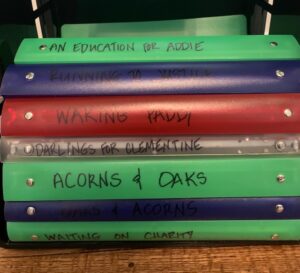No, I don’t write many blog posts anymore, and if you read my last two (one from 2022, one from 2021), you’ll know why my blog posts have withered on the vine. This year, I intend to write at least two a month. Why? To get back into the habit of writing (online, I’m still writing mostly in notebooks, by hand). I’ve also resolved to get out my old manuscripts and start working. I’m an old lady. Time is short.
This post is about my editing process.
How I Edit
Upon checking my external hard drive at the end of December 2022, I discovered I have seven manuscripts in various states of disrepair. Since I plan on doing something productive with my writing this year, I’ve decided to finish these novels, or start the editing process.
I’m a person who doesn’t really get technology. Find and replace gets me confused, which adds work, which means time, and time, I don’t have much of. Oh, my God, if it’s more complicated than that, I’m a lost cause. So I’ve decided to tackle the job the old fashioned way. This is how I used to edit, and I’m going back to it.
1. Print out the manuscript. Double spaced, with page numbers and jumbo margins. I print double sided to save paper. Page numbers are important for so many reasons.
2. Punch holes in manuscript, place in notebook. This way you won’t confuse it with the other six novels when a powerful wind (or clumsiness when you trip over a pile of tax documents and things go flying) blows your office to bits.
3. Read manuscript from front to back, DO NOT make notes or edit (yet). You’re only familiarizing yourself with what you wrote (and in my case, forgot) ten years ago.
4. Read the manuscript from back to front (yes, start at the last chapter, work your way to the first chapter). DO NOT make notes, even though by this time you are so dying to make corrections, your fingers are practically bleeding.
5. Start at the beginning. Read each chapter once, then make edits to each page. Have a LOT of sticky notes (big ones) because the double spacing and jumbo margins are not going to do it.
6. Resist the urge to make your corrections in the computer, even though it’s killing you not to. (Insert glass of wine/hit of premium whiskey HERE.)
7. When you have completed your manual edits, THEN start to edit in your computer. You might think of a few things to add as you’re making edits, and that’s just fine.
8. Upon completion of edits, print out the entire manuscript and reread. If you need to make a few more edits, do so now. Hopefully, you can fit those onto your double spaced pages and you won’t have to reprint the entire work. If it’s good enough, give to your friend, the BETA reader and have her look at it. (Your BETA reader will have to learn your way of editing in order to be a help, but really, it’s not that hard.)
9. The MOST IMPORTANT THING. SAVE your corrected work. Delete the original, as you have the printed copy, but only after you’ve completed edits. (I have an old, old computer that I’m not willing to give up just yet. I used to save every version of the manuscript which is silly, plus it takes up space.)
I’m certain that Millennials and Gen XYZs are shaking their heads in disbelief, but I have to have physical, tactile representations of working on my novels. Anything else and I’m totally lost in the weeds. Plus I need to look at my pile of notebooks. It’s like a cattle prod telling me to keep going.
I’m currently on Step 2 with the current work in progress. I like the story, I like the characters, and I’d really like to change things, but….not yet. I’m also currently away from home, in an undisclosed location for a week. It’s been a while since I’ve traveled alone, which I realize is where I do my best writing. This time away should afford me some time to at least get up to Step 6.
Next up, the true components of a story…








